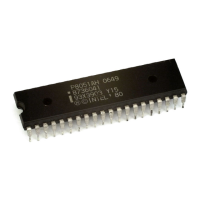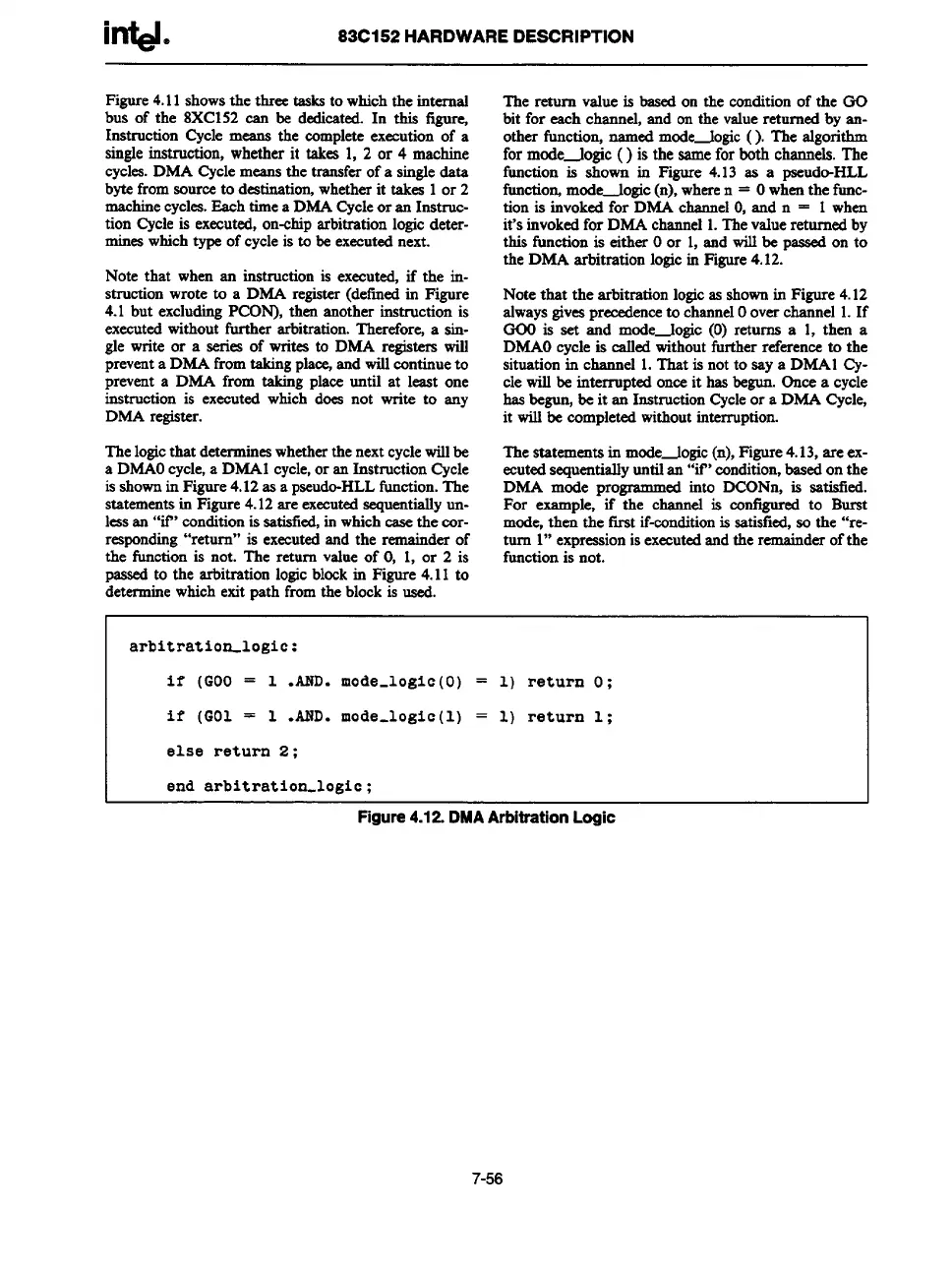i~.
83C152 HARDWARE DESCRIPTION
Figure4.11showsthe three tasksto whichthe internal
bus of the 8XC152can be dedicated.In this tigurq
Instruction Cycle means the completeexecutionof a
singleinstruction, whether it takes 1, 2 or 4 machine
cycles.DMA Cyclemeansthe transferof a singledata
bytefromsourceto destination,whetherit takes 1or 2
machinecycles.Eachtimea DMACycleor an Instruc-
tion Cycleis executed,on-chiparbitrationlogicdeter-
mineswhichtype of cycleis to be executednext.
Note that when an instructionis executed,if the in-
struction wrote to a DMA register(definedin Figure
4.1 but excludingPCON), tien snother instruction is
executedwithout further arbitration.Therefore,a sin-
gle write or a series of writes to DMA registers will
preventa DMAfromtakingpla% andwillcontinueto
prevent a DMA from taking place until at least one
instruction is executed which does not write to any
DMA register.
Thelogicthat determineswhetherthenextcyclewillbe
a DMAOcycle,a DMAI cycle,or an Instruction Cycle
isshownin Figure4,12as a pseudo-HLLfunction.The
statementsin Figure4.12are executedsequentiallyun-
lessan “it” conditionis sstisfi~ in whichcasethe cor-
responding“return” is executedand the remainder of
the function is not. The return value of O, 1, or 2 is
passedto the arbitration logicblockin Figure 4.11 to
detemninewhichexitpath fromthe blockis used.
The return value is basedon the conditionof the 00
bit for each channel,and onthe valuereturned by an-
other functio~ namedmodedogic (). The algorithm
for mode-logic () is the samefor both channels.The
function is shown in Figure 4.13 as a pseudo-HLL
functionjmode-logic (n),wheren = Owhenthe func-
tion is invokedfor DMA cbannelO,and n = 1 when
it’sinvokedfor DMA channel1.Thevaluereturnedby
this t%nctionis either Oor 1,and willbe passedon to
the DMA arbitration logicin Figure4.12.
Notethat the arbitrationlogicas shownin Figure4.12
alwaysgivesprecedenceto channelOoverchannel 1.If
000 is set and mode-logic (0) returns a 1, then a
DMAOcycleis called withouttiwtherreferenm to the
situationin channel 1.That is not to saya DMAI Cy-
cle willbe interrupted onceit has begun.Once a cycle
hasbegun,be it an InstructionCycleor a DMA Cycle,
it willbe completedwithoutinterruption.
Thestatements in modedogic (n),Figure4.13,are ex-
ecutedsequentiallyuntilan “if’ condition,basedonthe
DMA mode pro
grsmmed into DCONn, is sstistied.
For example, if the channel is configured to Burst
mode,then the first if-conditionis satisfied,so the “re-
turn 1“exrmssionis executedandthe remainderof
the
fimctioni; not.
arbitration-logic:
if (GOO= 1 .AND. mode-logic (0) = 1) return O;
if (GO1 = 1 .AND. modeJogic (1) = 1) return 1 ;
else return 2;
end arbitration-logic;
Figure 4.12. DMA Arbitration Logic
7-56

